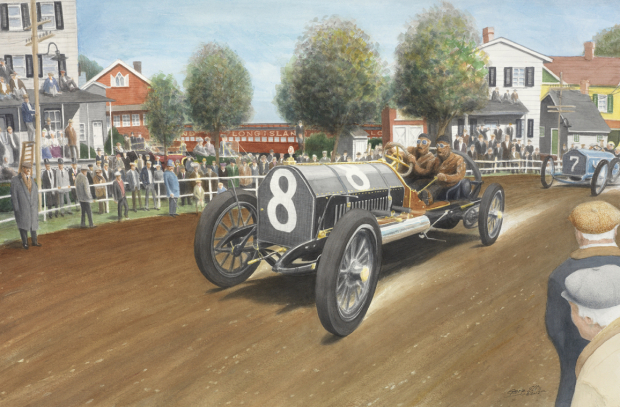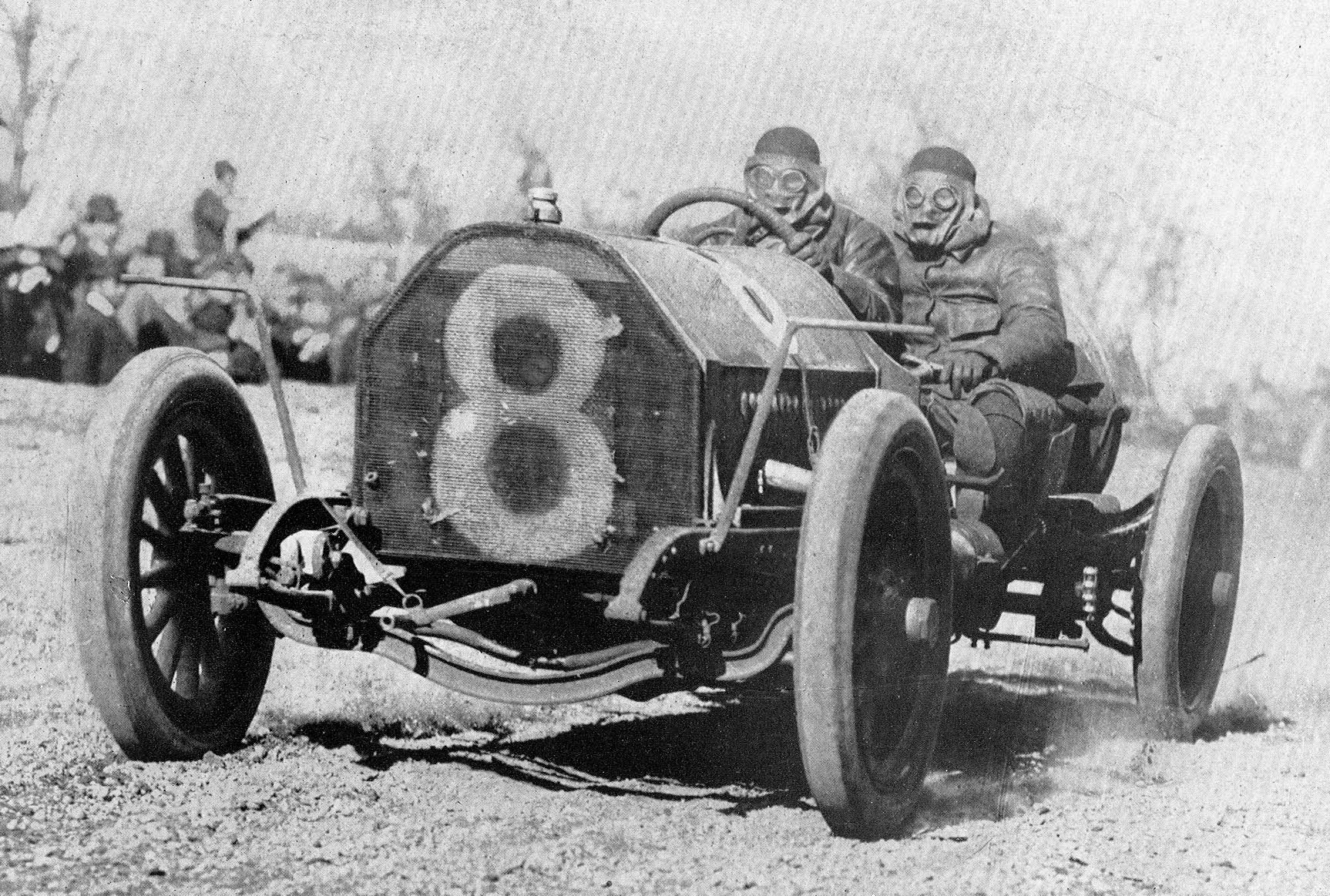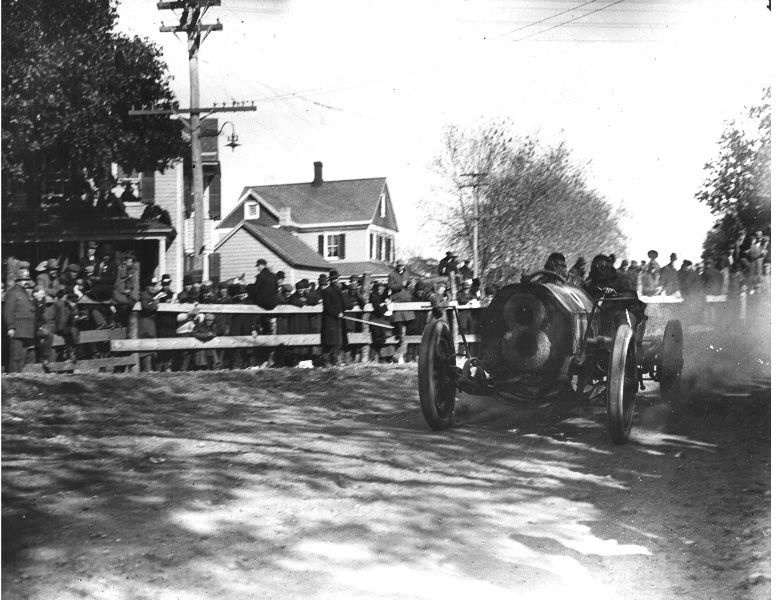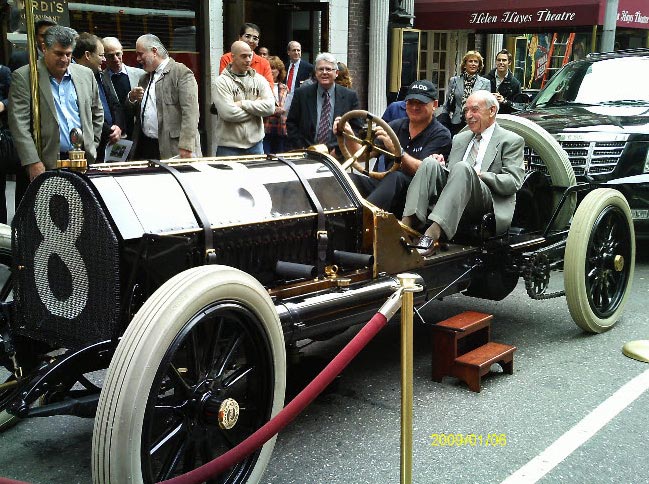The Making of an Alco Black Beast Watercolor Painting

Automotive artist George Ellis has painted this beautiful watercolor painting of the Alco Black Beast at the Hicksville Turn during the 1909 Vanderbilt Cup Race. George has provided this wonderful background information on the painting.
Enjoy,
Howard Kroplick
The Hicksville Turn
The 1909 Alco in the 1909 Vanderbilt Cup Race on Long Island
Artist: George Ellis, Northport, N.Y.
 This painting, “The Hicksville Turn,” is based on historical photographs featured in Howard Kroplick’s book, “Vanderbilt Cup Races of Long Island.” The scene is the 1909 race, won by the No. 8 1909 Alco driven by Harry Grant. Grant and mechanician Frank Lee wore leather masks to protect them from flying stones, which posed a challenge in that facial expressions would be difficult for an artist to portray. I decided to use their full bodies to provide expression, and I made the masks a bit different from the historical photos for the same reason.
This painting, “The Hicksville Turn,” is based on historical photographs featured in Howard Kroplick’s book, “Vanderbilt Cup Races of Long Island.” The scene is the 1909 race, won by the No. 8 1909 Alco driven by Harry Grant. Grant and mechanician Frank Lee wore leather masks to protect them from flying stones, which posed a challenge in that facial expressions would be difficult for an artist to portray. I decided to use their full bodies to provide expression, and I made the masks a bit different from the historical photos for the same reason.
 The scene depicted in this painting is likely fictional—the blue No. 7 Chalmers-Detroit, driven by Billy Knipper, led the race for 12 laps but retired after 20 laps; it may or may not have ever been close on the heels of the Alco as shown here. However, artists who reconstruct scenes from early racing commonly invent or exaggerate scenarios in the interest of capturing the true flavor of a race. My intention here has been to offer a general snapshot of what it must have been like to witness the race in person, as no color photographs exist and the pictures that were taken often are dark or blurry.
The scene depicted in this painting is likely fictional—the blue No. 7 Chalmers-Detroit, driven by Billy Knipper, led the race for 12 laps but retired after 20 laps; it may or may not have ever been close on the heels of the Alco as shown here. However, artists who reconstruct scenes from early racing commonly invent or exaggerate scenarios in the interest of capturing the true flavor of a race. My intention here has been to offer a general snapshot of what it must have been like to witness the race in person, as no color photographs exist and the pictures that were taken often are dark or blurry.
I combed Howard’s book for a couple of years before beginning this painting, studying the Hicksville turn, spectators, and scenery over and over again before finally making a sketch of the composition. I also noted the art cues evident in the posters for the races.
 I began with a photo of the Alco, now in Howard’s ownership, taken when he displayed it on 44th Street in New York City in front of Sardi’s restaurant, where the monthly meeting of the Madison Avenue Sports Car Driving and Chowder Society was being held, and Howard was the guest speaker. Yes, the car in this painting is actually adapted from a photo in Manhattan, and Howard himself was at the wheel, with architect and Bridgehampton race track devotee Guy Ladd Frost sitting in the mechanician’s seat.
I began with a photo of the Alco, now in Howard’s ownership, taken when he displayed it on 44th Street in New York City in front of Sardi’s restaurant, where the monthly meeting of the Madison Avenue Sports Car Driving and Chowder Society was being held, and Howard was the guest speaker. Yes, the car in this painting is actually adapted from a photo in Manhattan, and Howard himself was at the wheel, with architect and Bridgehampton race track devotee Guy Ladd Frost sitting in the mechanician’s seat.
I began with a large sheet of Arches watercolor paper measuring 22 by 33 inches, as I would need plenty of room to portray a crowd of spectators—a thinner crowd, in fact, than was at the scene, but I wanted each face to have some character without becoming so detailed as to distract from the focal point of the car.
The paints used are Windsor & Newton watercolors, and the painting was built up over several weeks with layer upon layer of transparent color to brighten colors and deepen contrasts. Many watercolorists work quickly, but my technique is to bring a painting up from the paper slowly, balancing color and contrast stage by stage until I’ve achieved the desired result. The payoff for using watercolor is the translucency of the medium, which gives a painting remarkable depth and warmth.
One of the challenges of watercolor is that opaque paints are traditionally not used except to fix mistakes. This painting has no opaque paint in it—where you see white, it is only the paper; no white pigment was used here. In places, temporary rubber masking fluid was applied—for instance, the stones in the road were masked off before I applied some layers of the brown washes to make the road, and the masking was then rubbed off.
The result, taken as a whole, is meant to convey a sense of what it must have been like to see these cars come hurtling around the course in color. The old-timers were witnessing the end of an age and the dawn of a new era, while the younger spectators were clearly excited as to what new wonders lay before them; some, no doubt, were eager to emulate Willie K. Vanderbilt Jr.and become daredevil race car drivers themselves.
My goal in making this painting was not only to capture the speed and action of the cars on this section of the course, but to capture a range of spectator types that were evident in the historical photos taken at the time. It is my hope, then, that viewers of this painting will enjoy the impression of seeing these powerful race cars in action, as well as the great excitement of the crowds during the dawning years of auto racing in America.
George Ellis
Northport, N.Y.
(631) 757-3722
www.georgeellis.com



Comments